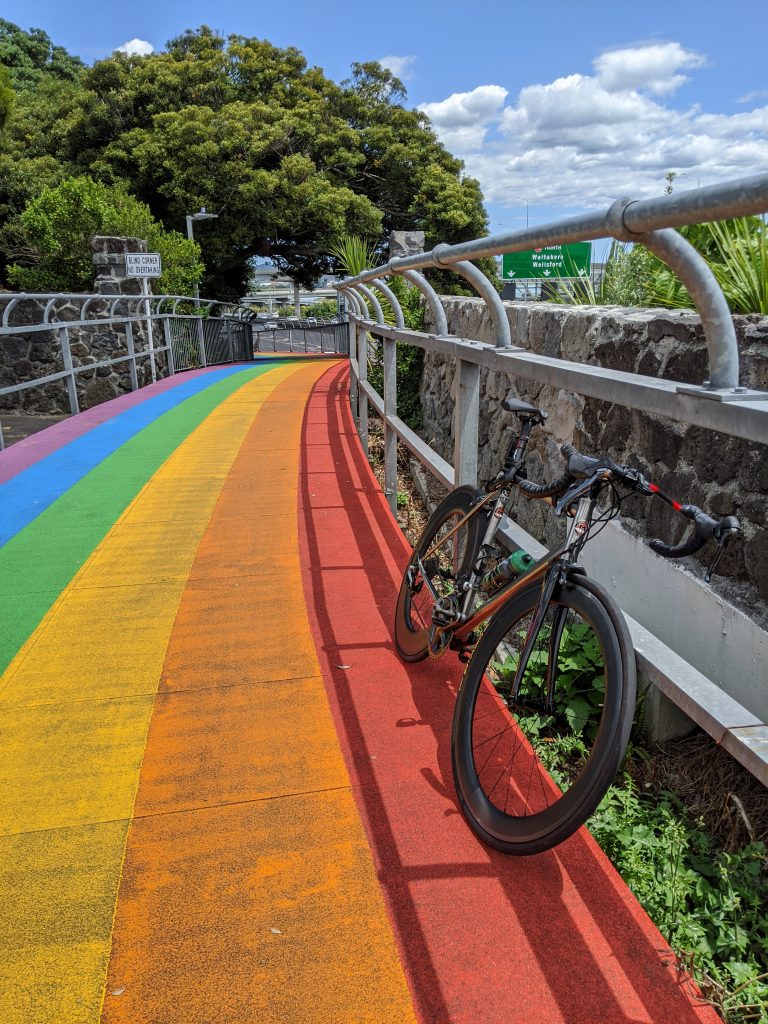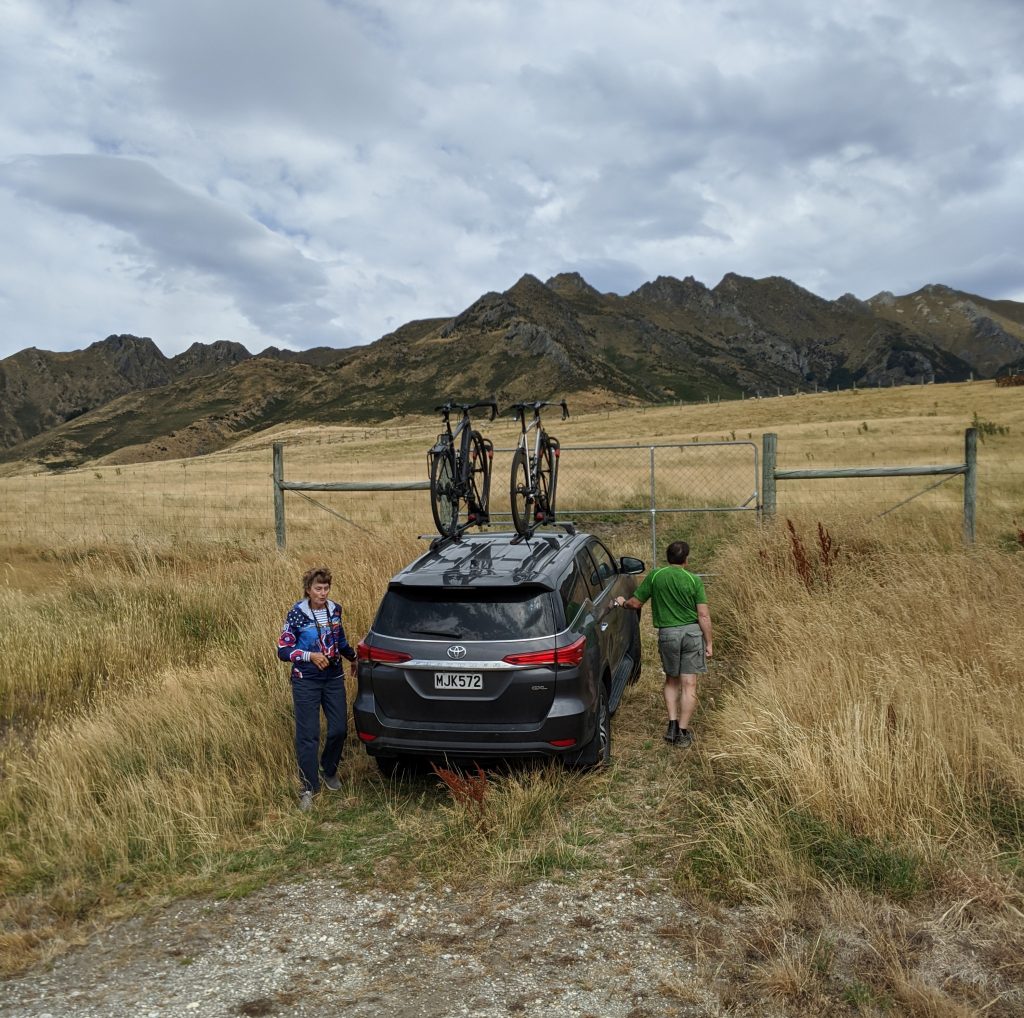Traveling with a bike is, in theory, one of the best ways to travel. Unlike bikepacking – where you carry all your stuff on your bike, here you just take your bike as part of your luggage and then go on rides like you would back home. Bikes offer most of the close-in scenery opportunity of hiking with speed that allows one to cover dozens of miles in an hour or two. Then there is the potential of Strava Segment tourism: veni vidi vici. Afterwards you can shower, dress up, and go to a museum appearing as a normal tourist, no one the wiser of the Strava secret agent you really are.
It is not, however, easily possible to travel ‘light’ when traveling with a bike nor especially with lots of cold weather clothes. In Sweden last year, I stayed in one place for a month, then shipped my athletic stuff back home before switching to a more intensive backpacker vacation. In New Zealand this spring, I traveled with my parents in a rented SUV, stuffed absolutely full of stuff. Similar story traveling in the US, with a car packed full of stuff.
Be prepared against bike theft, always keep the bike locked in a car or your own room. One bike of mine was stolen in Sweden out of a locked ‘secure’ room in which it was in turn locked with a bike lock, in all probability stolen by some of the maintenance staff. Interestingly, my heavily-disassembled bike in its Orucase black bag is apparently a much less attractive theft target. I guess a heavy pile of greasy parts does not have the immediate appeal of an assembled, glossy race bike.
Running and swimming can be done with much less equipment, but they are, of course, much less fun. Rental bikes are possible, but are generally low quality, sporadically available, and yet very expensive to rent (the exception appears to be Scandinavia: in Denmark I rented a nice carbon frame for something like $30/day). I snagged some KOMs in both Gotland and New Zealand on hybrid commuter-style bikes, but in general rental bikes aren’t capable of performance.
As for bike bags, I have an Orucase and my dad has a Scicon bag. The Scicon is much nicer but twice the size. The Orucase takes more time and tools to disassemble into, but then passes as normal checked luggage. My sister used some generic hard-cases, which were even larger, on the positive side she could pack most of her clothes and regular travel gear in them as well. Regardless of how nice the case, you should probably assume your frame will suffer cosmetic scratches. I travel these days with an unpainted titanium frame – I recommend either titanium or aluminum bikes for travel over carbon.

Note on e-bikes: maximum battery sizes for airlines are rather small by e-bike standards. Best to travel with the solely human-power kind, generally. My dad has taken his Specialized Creo with the main frame battery removed and used instead 3 smaller external batteries. That got him around 50 miles of range, and worked well enough, but required a rack on his bike to carry the spare batteries. Batteries must also be taken in a carry-on.
The following is a list for traveling with a bike (not bike packing) to places where cool weather is expected. Some or all of this stuff can be bought on location too (like a bike pump). CO2 cartridges for pumps definitely have to be bought if you fly, as they can’t be taken on planes.
This is also a list for longer trips (several weeks at least). If you are only traveling, for say, a week, a rental bike probably makes more sense (if you can find a good rental place in advance), just bring your own helmet and pedals/shoes.
- Athletic Clothes
- 1x skinsuit for Strava KOMs
- 2x cycling kit
- 2+ athletic socks
- Cold, if needed
- Shoe covers and/or warm socks
- helmet liner
- middleweight gloves
- 2x warm tights
- 2x heavy upper underlayer
- cycling shoes
- running shoes
- 2x running top/bottom (can double as casual wear in a pinch)
- swimwear + goggles
- Daily Wear
- 3x shirts
- 2x t-shirts
- 2x travel pants
- 2x regular pants/shorts
- casual shoes
- pajamas
- 5+ underwear
- 5+ socks (including wool)
- Belt
- Hat
- Cold Weather Clothes, if needed
- Lightweight gloves
- Wool hat
- Rain jacket (depending on destination)
- Warm jacket (if traveling from somewhere cold to somewhere warm, I take the lighest jacket I can that won’t leave me too cold while leaving)
- Sweatpant/shirt set
- Cycling Equipment
- Bike in bike bag/case (well-padded and protected)
- Pedals (Power meter pedals + charging cord)
- Bike pump (largest small one available)
- Helmet
- Sunglasses
- Heart rate monitor
- Garmin cycling computer + maps
- Garmin wristwatch + charging cord
- 2x water bottles
- Repair kit (2x CO2, CO2 pump with adjustable valve, spare tire(s), patch kit, multitool, chain missing link, some local currency) (CO2 is supposedly regulated on flights but I’ve never had issues with the small canisters place inside a bag inside a bag)
- Chain bike lock, optional
- swim resistance cable (for swim training without a pool) (optional)
- Electronics
- Work laptop
- Personal laptop
- Portable external monitor (optional) (I never bring this anymore)
- Mouse/Travel Keyboard/Laptop Stand (optional)
- iPad + Cord + Stand
- Kindle/e-reader
- USB-C PD cords and power supplies
- Travel Power Adapters (I buy power supplies where I can switch a head or three prong ac cord out, rather than the bulky international everywhere adapter, although I bring one of those too)
- Noise-cancelling headset
- Workout headset
- Phone 1
- Phone 2 (Local sim) (I use an old phone for this), optional
- Travel Router or Hotspot (optional)
- Flash drive (optional)
- Battery pack with appropriate charging cord, remember all lithium batteries need to be in carry-on bags for flights
- Nicer camera, optional
- Important and Misc
- Passport
- Wallet + Cards (with backups in different locations in case you lose your wallet) (RFID blocking is actually useful, I use an electronics ziploc)
- Contact Lenses
- Glasses
- 1+ Face masks
- Pens + Notebook
- Shopping/Tote bag(s)
- Lock (if staying at hostels at some point)
- Packing cubes/compression bags
- Repair/camping: some tape and parachute cord, camping utensils, water purification tablets, needle and thread)
- Water Purification filter (if you planning on long hiking or visiting locations with unfriendly bacteria in the water)
- AA and 2032 coin cell batteries, you can just about always find these in local stores easily enough, but nice to have if you are expecting a change soon
- Food storage containers, doubling as packing containers, optional
- 150 metric tons of JIF reduced fat peanut butter!
- Toiletries
- First aid kit (band aids/bandages, antibiotic cream, NSAIDs, antihistamines)
- Toothbrush and toothpaste
- Hand sanitizer/wipes
- Shaving
- Shampoo (in the largest small size you can find) (you can buy more locally but nice to have a starter)
- Travel towel (bigger if staying at hostels, smaller if staying where towels are provided)
- Sunscreen + Bug spray (seasonal)
- Nail clippers
- Qtips
- A few laundry detergent pods or similar as a starter
Packed roughly like this for a long trip, I had a 45 lb (20 kg) suitcase, a 35 lb (16 kg) bike bag, and a medium-sized carry on backpack (itself weighting 15 lbs because it had a ton of electronics in it). Like I said, traveling light and traveling with a bike are mutually exclusive.
To Do Before Departure
- Choose your destination(s) and timetable. Plan some highlight activities to do, but don’t plan all of your time.
- Try to find local events/festivals/races which will occur while you are there.
- Book flight
- If using a discount airline, check all their possible fees, pre-pay for luggage
- Book hotel/stay
- Figure out how you’ll get from airport to your first stay. Be prepared to make this trip while exhausted.
- If working during the trip, try to find a place with a desk and good internet
- Download offline maps (Google Maps, Garmin maps, etc) for your destination before you leave.
- Investigate your destination’s cellular data offerings, and whether your current plan covers international travel. Check to see if your phone is compatible with their data bands (advanced). Verizon is stupidly expensive to travel with. Google Fi and T-Mobile works much better internationally, although local data sims may still be cheaper.
- Call bank(s) (if necessary) to notify them of travel
- Move extra funds out of account linked to the debit card you bring (I do this as a precaution, to reduce possible loss if stolen)
- In a carry on bag, pack everything (include spare clothes and basic toiletries) you need for a day or two if checked luggage goes stray.
- Checked luggage is far more convenient. Always use checked bags unless your trip is very short (3 days?).
- Travel slow, when possible. More time makes things much less stressful. Plan for delays and flight changes
- Print critical documentation, and have backups of ID, etc. But don’t print everything, because you can use your phone or a computer for most things these days.
- Check travel entry requirements for your destination(s). More countries these days have ‘e-visas’ for most visitors which, while not a visa in the traditional sense, are forms you have to fill out, and a small fee.
- Get a haircut, a dental appointment, and any medical appoints you might need in the near future.
- Clean your home before you leave, it’s nice to come back to it that way.
- Check the expected weather at your destination.
- Book tickets or reservations if you plan to go to anything which is crazy popular. This applies probably more to the big tourist cities like Paris and Rome at the height of tourist season.
- Learn some of the language, if necessary. Honestly, however, English is all you need most places and you’ll almost never understand the local language well enough to use it unless you study the language for years. But do learn well, “hello”, “please”, and “thank you” in the local language. Download the offline version of the language in Google Translate on your phone so you can figure stuff out when necessary.

